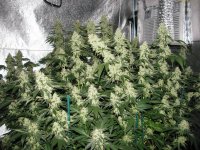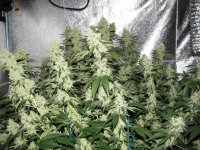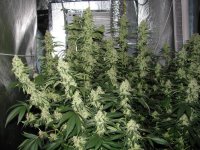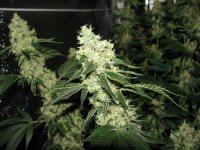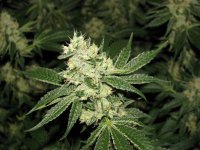You are using an out of date browser. It may not display this or other websites correctly.
You should upgrade or use an alternative browser.
You should upgrade or use an alternative browser.
Indoor No Till Deep Soil Bed
- Thread starter organicterra
- Start date
Does anybody else treat there soil beds like a compost and vermicompost bin all at the same time? I just throw most of my compostables into the bed and the worms take care of it pretty quickly. I figured why have different bins all over.
I occasionally mulch my no-till tote with leftover organic salad greens and carrot tops.
Pine
G
growingcrazy
I occasionally mulch my no-till tote with leftover organic salad greens and carrot tops.
Pine
Awesome! I am glad that I am not the only one!
I usually cut up veggie scraps nightly and toss them in a freezer bag and then into the freezer. Once there completely frozen I break them into smaller pieces or toss em in the blender. Then work them into the top 3" of soil. I usually stick to squash, eggplant and cucumber skins, banana peels, apple peals, broccoli stems and things of that nature. No "real" fruits or veggies, mainly skins.
Very very nice indeed.
I have been wondering if it is a good idea to start op a indoor bed soon?? I really don't whant to add any store products other than compost tea, kelp and dry ferts (diffrent weeds) My qyestion is, can this indoor bed stand "forever" by that I mean, one do not have to put the used soil throgh the compost ? (Sorry I'am very new in this area, so hope not, that my questions is to dumb )
Regards The Imperium.
Btw. Is there any step by step guide on the subject indoor bed?? Have been searching and can't find any good guide.

I have been wondering if it is a good idea to start op a indoor bed soon?? I really don't whant to add any store products other than compost tea, kelp and dry ferts (diffrent weeds) My qyestion is, can this indoor bed stand "forever" by that I mean, one do not have to put the used soil throgh the compost ? (Sorry I'am very new in this area, so hope not, that my questions is to dumb )
Regards The Imperium.
Btw. Is there any step by step guide on the subject indoor bed?? Have been searching and can't find any good guide.
organicterra
Member
Here's a couple shots from Mon. night. Day 49. Three weeks to go.
I gave them a comfrey tea last watering. About 1 cup for each of two 5 gallon buckets of water.
I gave them a comfrey tea last watering. About 1 cup for each of two 5 gallon buckets of water.
Attachments
you must be so psyched every time you open your tent 
such an interesting thread... you mentioned you add glacial rock dust to the soil. how long before it gets consumed by the microbes and becomes depleted... also if anyone can provide links on no till, i wanna get as much info as possible?... thanx
Day 28 flower.
I'm curious to hear some thoughts on how to manage this bed over the long term.
One unknown is how quickly the old root systems will breakdown and if there are any potential issues with running this type of no till bed as a perpetual flower room with no real breaks in between rounds.
Any thoughts?
No breaks between rounds is best. All the critters in the rhizosphere are there at the time you cut but quickly subsude and go dormant as soon as plants are removed. Just cut and immediately put next clones in the gaps.
Food goes in via the top I use long term amendments mulch and compost, nothing fancy. Add a worm castings brew on transplant - golden.
No breaks between rounds is best. All the critters in the rhizosphere are there at the time you cut but quickly subsude and go dormant as soon as plants are removed. Just cut and immediately put next clones in the gaps.
Food goes in via the top I use long term amendments mulch and compost, nothing fancy. Add a worm castings brew on transplant - golden.
Wurd!
If there's one guy that you all should listen to on this no-till stuff..this is your guy. Fista definitely gave me the much needed advice to even start out trying no-till. Now I'm 3 cycles into the same pots basically doing the above mentioned practices.
organicterra
Member
No breaks between rounds is best. All the critters in the rhizosphere are there at the time you cut but quickly subsude and go dormant as soon as plants are removed. Just cut and immediately put next clones in the gaps.
Food goes in via the top I use long term amendments mulch and compost, nothing fancy. Add a worm castings brew on transplant - golden.
Right on, Thanks MrFista and CC1!Wurd!
If there's one guy that you all should listen to on this no-till stuff..this is your guy. Fista definitely gave me the much needed advice to even start out trying no-till. Now I'm 3 cycles into the same pots basically doing the above mentioned practices.
Right now my plan is to harvest the current plants, pull off the bark mulch, top dress with homemade compost and bagged ewc at about 4:1. I'd like to add about 2" of new material. I think I'll try spreading some clover seed prior to transplanting to see if I can get a mulch going.
I made the soil mix pretty hot so I don't think I'll add any dry ferts this round.
I'll probably add some endo spores in the planting holes also.
How's that sound?
I've been thinking about sending some soil in to a lab for testing so I can get a baseline for future reference.
organicterra
Member
Hell yeah! The smell is delicious and it's a lot of fun watching them chunk up.you must be so psyched every time you open your tent
Thanks! Not sure how long the rock duct sticks around but I'd guess quite a while. Probably longer than most other things.such an interesting thread... you mentioned you add glacial rock dust to the soil. how long before it gets consumed by the microbes and becomes depleted... also if anyone can provide links on no till, i wanna get as much info as possible?... thanx
Yep. Both.That sounds pretty exciting. Do you add neem or crab meals?
Very exciting! I can't wait to see how this soil performs in the months to come. Especially when my worm trays start producing and my compost has some time to age.
That along with the comfrey, dandelion and yarrow inputs things should be nice and healthy.
organicterra
Member
rrog, here is my mix.Soil mix.
Base mix is peat moss, coco coir, compost, ewc and pumice/perlite.
Amendments are neem seed meal, fish meal, fish bone meal, alfalfa meal, soybean meal, soft rock phosphate, kelp meal, crab meal, k mag, oyster shell powder, gypsum, dolomite lime, and a hefty dose of glacial rock dust.
My compost component is made up of homemade compost, malibu bu's blend and marwest.
organicterra
Member
Yeah he's been a tremendous help in getting me to where I am now.
Thanks CC!
Sounds really good. I'm glad this no till thing is taking off because it's so easy to be fully organic this route. Not to mention conserving things down to a microbial scale - it's pretty darn green! MM was the original inspiration and pioneer tinkerer for this project.
I deliberately added no Nitrogen for 5 grows in a row. I had no nitrogen deficiency (measured it). I put this down to free living N fixers in the soil (e.g. frankia actinobacteria - facultative symbionts). These guys 'arrive' (get to work) when carbon is high and N is limited. Interestingly cannabis is of the Rosales family. Some Rosales are known to associate with frankia.
Now recalling Jays favourite mantra (less is best) be aware of your inputs and try not to dump lots of rich matter in there hoping for miracles. Compost and worm castings is golden, a bunch of veggie scraps yeah, no hardcore ferts, sprinkles of rockdusts, rock guano even, IF the soil needs it. FPE's are magic, I'm just a bit lazy on that front so keep adding worm castings in the water and that's about it while the grow is on.
I'm a big fan of mycorrhizae, and am of the opinion if you have the spores round planting time by all means use them. Mycorrhizae often sporulate under plant stress so hoping when I cut the last plants down sporulation is occuring in my soil. With only a month in veg then turnover, and an 8 weekish time for the association to take place, I'm only getting the myco benefits for the last month of flowering if at all. Two months sounds a long time I'd like to see the source of that 'information'...
Here's a bit more from my notes on N fixing - next post....
I deliberately added no Nitrogen for 5 grows in a row. I had no nitrogen deficiency (measured it). I put this down to free living N fixers in the soil (e.g. frankia actinobacteria - facultative symbionts). These guys 'arrive' (get to work) when carbon is high and N is limited. Interestingly cannabis is of the Rosales family. Some Rosales are known to associate with frankia.
Now recalling Jays favourite mantra (less is best) be aware of your inputs and try not to dump lots of rich matter in there hoping for miracles. Compost and worm castings is golden, a bunch of veggie scraps yeah, no hardcore ferts, sprinkles of rockdusts, rock guano even, IF the soil needs it. FPE's are magic, I'm just a bit lazy on that front so keep adding worm castings in the water and that's about it while the grow is on.
I'm a big fan of mycorrhizae, and am of the opinion if you have the spores round planting time by all means use them. Mycorrhizae often sporulate under plant stress so hoping when I cut the last plants down sporulation is occuring in my soil. With only a month in veg then turnover, and an 8 weekish time for the association to take place, I'm only getting the myco benefits for the last month of flowering if at all. Two months sounds a long time I'd like to see the source of that 'information'...
Here's a bit more from my notes on N fixing - next post....
Plants require nitrogen and most of these acquire it through assimilation of Nitrate or Ammonium from soil water. The majority of N is held in the atmosphere or dissolved in water in gaseous N2 form which is an extremely hard molecule to reduce. The ability to fix N is relegated to a small number of diazatrophs including cyanobacteria. Some fix N as free living organisms (archaea, eubacteria), some as symbiotic organisms (rhizobia), some as both (actinobacteria).
Among the organisms that fix Nitrogen in symbiosis are:
Root nodules associated with Rhizobium spp and the Fabaceae family - of significant agricultural importance fixing a large portion of the N used in these systems.
Nodules from frankia actinobacteria in Fagaceae, Rosaceae and Cucurbitaceae.
Cyanobacteria have associations with many organisms including Angiosperms, gymnosperms, bryophytes, fungi and diatoms.
N2 + 16ATP + 8H+ -> 2NH3 + 16 ADP + 16 Pi + H2
The enzyme nitrogenase reduces N2 to NH3. The process is extremely expensive taking 12 to 17 grams of carbohydrates from the plant in exchange for one gram of N fixed. The enzyme is rapidly and irreversibly inhibited by O2.
Nitrogenase is made up of two proteins: Fe-protein (dinitrogenase reductase, 2 subunits) transfers electrons to the Mo-Fe protein (dinitrogenase, 4 subunits). The subunits have functional groups attached: Mg-ATP on dinitrogenase reductase and FeMo, FeV or FeFe on dinitrogenase. These other types of functional groups all serve the same purpose. Together both of these proteins form the active enzyme nitrogenase.
Nitrogenase has a very low catalytic affinity, and is extremely sensitive to oxygen. To overcome this bacteria produce vast amounts of the enzyme and employ specific strategies to avoid oxygen.
Behavioral barriers include tight clumping together of cells making a low oxygen centre (Trichodesmium), or fixing N2 at night (Gloethece). Some form physical barriers e.g. heterocysts (cyanobacteria), or they have thick walled cells. Some have no photosystem II so they don’t evolve oxygen. Some use biochemical barriers e.g. leghaemoglobin which has an extremely high affinity for 02.
Forming a Root Nodule.
Rhizobia-legume root nodulation is not obligatory and does not occur where soil nitrogen is sufficient for a plants use as it is very costly to the plant (12-17g carb for 1g N). This association is of tremendous economic importance (peanuts, peas, soy, lentils etc). The rhizobia are free living motile rods; they occur in low numbers and do not fix N in the soil. They are typically not found in soils that have not previously had legumes, but when N deficiency occurs, the partners seek each other out through chemical signaling.
Each strain of rhizobia has a limited number of potential host plants. When the rhizobia are in the plant they become bacteroids. Bacteroids are larger, have morphological variance according to host species, their cell walls become invaginated, and their membranes become highly permeable.
Plant genes specific to nodules are called nodulin (NOD) genes.
Bacterial genes specific to nodules are called nodulation (nod) genes.
nod A-C are common. nod D is common and regulates transcription of other nod genes.
nod e,f etc are host specific genes.
Plants control the rhizobial association and root nodule formation. Plants signal the bacteria with chemical attractants (flavonoids and betaines) and rhizobia move toward the plant using chemotaxis. As rhizobia attach to lectins on the root hairs rhizobial nod D proteins are activated which induce transcription of nod factors (lipochitin oligosaccharides) some of which induce curling of the root hair by the plant host where rhizobia proliferate in the coils. Localized degradation of the root hair wall occurs and an infection thread is developed from Golgi secretory vesicles from the root hair cells. The infection thread then reaches the end of the cell and fuses with the cell membrane. They degrade the cell wall at the end and sides of the infection thread. Rhizobia then enter the apoplast and penetrate the middle lamella and through to the plasma membrane of the cell beneath. This leads to initiation of a new infection thread that forms an open channel with the first. The infection thread extends and branches until it reaches target cells where vesicles of plant membrane enclose the bacteria and bacterial division occurs continuously until some unknown signal from the plant, where transition to bacteroids commences. Nodules can be elongated (peas) or spherical (soy).
Bacteroids release ammonia to the plant. Glutamine synthase activities are low in the bacteroids but high in the host plant cell. Nitrogen is assimilated into N rich compounds for export e.g. allantoin C:N = 1. Host provides dicarboxylic acids to the bacteroids e.g. succinate, fumarate, and malate; these provide energy and reductant for N fixation.
Among the organisms that fix Nitrogen in symbiosis are:
Root nodules associated with Rhizobium spp and the Fabaceae family - of significant agricultural importance fixing a large portion of the N used in these systems.
Nodules from frankia actinobacteria in Fagaceae, Rosaceae and Cucurbitaceae.
Cyanobacteria have associations with many organisms including Angiosperms, gymnosperms, bryophytes, fungi and diatoms.
N2 + 16ATP + 8H+ -> 2NH3 + 16 ADP + 16 Pi + H2
The enzyme nitrogenase reduces N2 to NH3. The process is extremely expensive taking 12 to 17 grams of carbohydrates from the plant in exchange for one gram of N fixed. The enzyme is rapidly and irreversibly inhibited by O2.
Nitrogenase is made up of two proteins: Fe-protein (dinitrogenase reductase, 2 subunits) transfers electrons to the Mo-Fe protein (dinitrogenase, 4 subunits). The subunits have functional groups attached: Mg-ATP on dinitrogenase reductase and FeMo, FeV or FeFe on dinitrogenase. These other types of functional groups all serve the same purpose. Together both of these proteins form the active enzyme nitrogenase.
Nitrogenase has a very low catalytic affinity, and is extremely sensitive to oxygen. To overcome this bacteria produce vast amounts of the enzyme and employ specific strategies to avoid oxygen.
Behavioral barriers include tight clumping together of cells making a low oxygen centre (Trichodesmium), or fixing N2 at night (Gloethece). Some form physical barriers e.g. heterocysts (cyanobacteria), or they have thick walled cells. Some have no photosystem II so they don’t evolve oxygen. Some use biochemical barriers e.g. leghaemoglobin which has an extremely high affinity for 02.
Forming a Root Nodule.
Rhizobia-legume root nodulation is not obligatory and does not occur where soil nitrogen is sufficient for a plants use as it is very costly to the plant (12-17g carb for 1g N). This association is of tremendous economic importance (peanuts, peas, soy, lentils etc). The rhizobia are free living motile rods; they occur in low numbers and do not fix N in the soil. They are typically not found in soils that have not previously had legumes, but when N deficiency occurs, the partners seek each other out through chemical signaling.
Each strain of rhizobia has a limited number of potential host plants. When the rhizobia are in the plant they become bacteroids. Bacteroids are larger, have morphological variance according to host species, their cell walls become invaginated, and their membranes become highly permeable.
Plant genes specific to nodules are called nodulin (NOD) genes.
Bacterial genes specific to nodules are called nodulation (nod) genes.
nod A-C are common. nod D is common and regulates transcription of other nod genes.
nod e,f etc are host specific genes.
Plants control the rhizobial association and root nodule formation. Plants signal the bacteria with chemical attractants (flavonoids and betaines) and rhizobia move toward the plant using chemotaxis. As rhizobia attach to lectins on the root hairs rhizobial nod D proteins are activated which induce transcription of nod factors (lipochitin oligosaccharides) some of which induce curling of the root hair by the plant host where rhizobia proliferate in the coils. Localized degradation of the root hair wall occurs and an infection thread is developed from Golgi secretory vesicles from the root hair cells. The infection thread then reaches the end of the cell and fuses with the cell membrane. They degrade the cell wall at the end and sides of the infection thread. Rhizobia then enter the apoplast and penetrate the middle lamella and through to the plasma membrane of the cell beneath. This leads to initiation of a new infection thread that forms an open channel with the first. The infection thread extends and branches until it reaches target cells where vesicles of plant membrane enclose the bacteria and bacterial division occurs continuously until some unknown signal from the plant, where transition to bacteroids commences. Nodules can be elongated (peas) or spherical (soy).
Bacteroids release ammonia to the plant. Glutamine synthase activities are low in the bacteroids but high in the host plant cell. Nitrogen is assimilated into N rich compounds for export e.g. allantoin C:N = 1. Host provides dicarboxylic acids to the bacteroids e.g. succinate, fumarate, and malate; these provide energy and reductant for N fixation.
Nodules from frankia actinobacteria in Fagaceae, Rosaceae and Cucurbitaceae.
can you talk about this a bit more? I did not know about cucurbits and actinobacter. is it a significant source?

